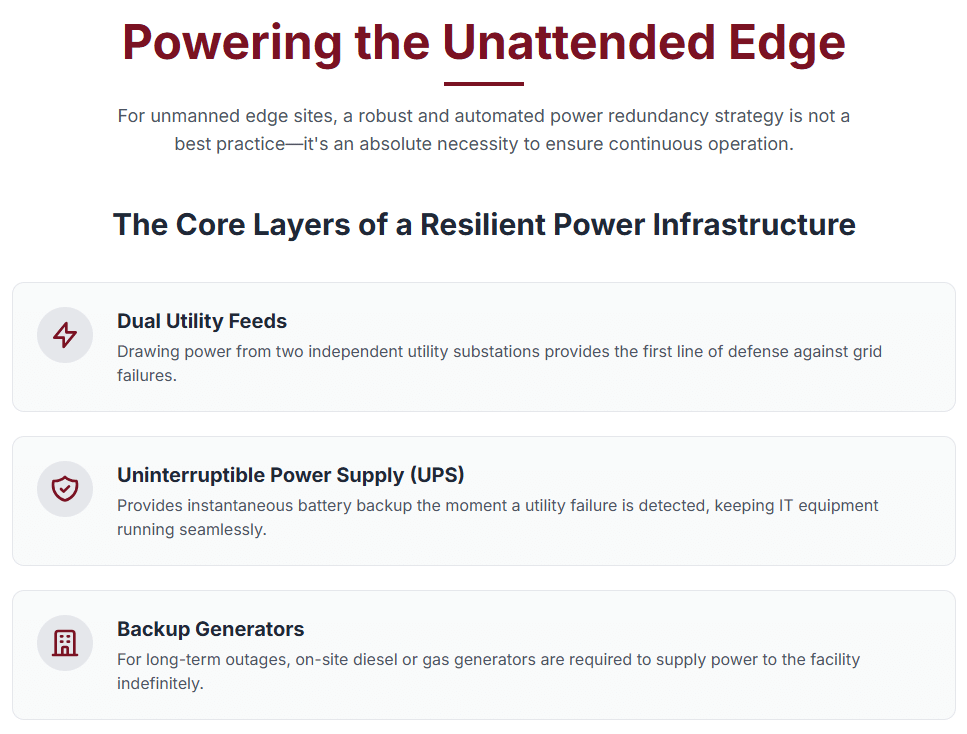Edge Power Management for High-Density Sites
Published on July 11, 2025,
by
Edge Power Management for High-Density, Unattended Sites
As edge computing continues to expand, the infrastructure supporting it must evolve to meet new challenges. Among the most critical of these is power. For high-density, unmanned edge data centers, edge power management is not just a technical concern—it’s a foundational requirement for uptime, reliability, and operational continuity.
Unlike traditional data centers, edge sites are often deployed in remote or hard-to-reach locations, with no on-site personnel to respond to outages or failures. This makes power redundancy and thermal management essential components of any edge deployment strategy. In this post, we’ll explore the key elements of a resilient power architecture, the shift toward lithium-ion battery technology, and how these innovations are shaping the future of edge infrastructure.

Why Power Redundancy Matters at the Edge
Every mission-critical facility depends on a constant and reliable power supply. But for edge data centers—especially those operating without on-site staff—this need becomes even more urgent. A power failure at an unattended site can lead to service disruptions, data loss, and costly downtime.
To mitigate these risks, edge power management strategies must include multiple layers of redundancy. These are typically defined using configurations such as:
- N+1: One additional backup component for every critical system.
- 2N: Full duplication of all critical components.
- 2(N+1): Two fully redundant systems, each with an extra backup.
These configurations ensure that if one component fails, another can immediately take over, maintaining uninterrupted service.
Core Components of a Resilient Edge Power System
A robust edge power management strategy includes several key components, each playing a vital role in ensuring uptime:
1. Dual Utility Feeds
Where feasible, edge sites should draw power from two independent utility substations. This provides a first line of defense against grid-level failures. If one feed goes down, the other can continue supplying power without interruption.
2. Uninterruptible Power Supply (UPS)
A UPS system is essential for bridging the gap between a utility failure and the activation of backup generators. It provides instantaneous battery power to keep IT equipment running during this critical transition period. Without a UPS, even a brief power loss could result in system crashes or data corruption.
3. Backup Generators
For extended outages, on-site generators—typically diesel or gas-powered—are required to sustain operations. These generators can keep the facility running indefinitely, or at least until utility power is restored. Automated start-up and fuel monitoring systems are crucial for ensuring reliability in unmanned environments.
The Shift to Lithium-Ion Batteries

One of the most significant trends in edge power management is the transition from traditional Valve-Regulated Lead-Acid (VRLA) batteries to lithium-ion batteries in UPS systems. While VRLA batteries have been the industry standard for decades, they come with several limitations that make them less suitable for edge environments.
Advantages of Lithium-Ion Batteries:
- Smaller Footprint: Lithium-ion batteries are more compact, making them ideal for space-constrained edge deployments.
- Longer Service Life: They typically last 2–3 times longer than VRLA batteries, reducing replacement frequency and maintenance costs.
- Lower Maintenance: Lithium-ion systems require less routine maintenance, which is critical for unmanned sites.
- Higher Efficiency: They operate more efficiently, reducing energy waste and improving overall system performance.
These benefits make lithium-ion technology a natural fit for the edge, where reliability, efficiency, and low maintenance are top priorities.
Thermal Management for High-Density Edge Sites
Power and thermal management go hand in hand. High-density edge deployments generate significant heat, and without proper cooling, equipment can overheat and fail. Effective thermal management strategies include:
- Passive Cooling: Leveraging ambient air or natural ventilation in cooler climates.
- Active Cooling: Using compact HVAC systems or liquid cooling for high-performance environments.
- Environmental Monitoring: Sensors that track temperature and humidity in real time, triggering alerts or automated responses when thresholds are exceeded.
Integrating thermal management into your edge power management plan ensures that systems remain within safe operating conditions, even during peak loads or extreme weather.
Automation and Remote Monitoring
Because edge sites are often unmanned, automation and remote monitoring are essential. Intelligent power management systems can:
- Monitor battery health and generator fuel levels
- Detect anomalies in power flow or temperature
- Trigger alerts or automated failover responses
- Provide real-time visibility into system performance
These capabilities allow operators to manage large fleets of edge sites efficiently, reducing the need for on-site intervention and improving overall uptime.
Final Thoughts: Building Resilient Edge Infrastructure
As edge computing continues to scale, the importance of robust edge power management cannot be overstated. From redundant power configurations and lithium-ion UPS systems to intelligent monitoring and thermal control, every component plays a role in ensuring continuous, reliable service.
Organizations that invest in resilient power and thermal strategies today will be better equipped to support the next generation of digital services—whether it’s autonomous vehicles, smart cities, or real-time analytics.
